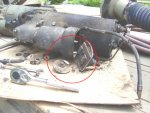Beryllium copper is commonly use for springs in electrical contacts. It is fairly low resistance, like copper, but unlike copper, it is springy when properly heat treated, and can withstand a near infinite number of flex relax cycles.
...But...
It is only occasionally used, by itself, as a contact material. It presents no special characteristics to that task. More commonly, a more suitable contact material is fused, or riveted to the beryllium copper spring, to form the contact assembly of a relay, or solenoid.
When it is talked of beryllium copper being non-sparking, what is being discussed is the lack of a glowing hot metal particle being dislodged when the metal is rapidly mechanically cut.... unlike steels. This property makes beryllium copper a valuable material for making hammers, chisels, and other tools used in explosive atmospheres... like around a leaking gasoline pipeline.
I am certain that most cheap starter solenoids are using a nearly pure, but work hardened, copper alloy for their contacts, Premium starter solenoids use a copper nickel silver alloy for their contacts because of its low welding and material transfer characteristics.
If you do a quick google search, you will find that virtually all starter solenoid parts, needed to rebuild your solenoid, are readily available.
-Chuck






 and a carcinogen it WILL give you cancer
and a carcinogen it WILL give you cancer Ghostdriver had several Jaguars and still has a cabriolet. I Know she will find this almost as funny as when she discovered her fuel was being run through the air conditioner to cool it down to avoid vapor lock.
Ghostdriver had several Jaguars and still has a cabriolet. I Know she will find this almost as funny as when she discovered her fuel was being run through the air conditioner to cool it down to avoid vapor lock.